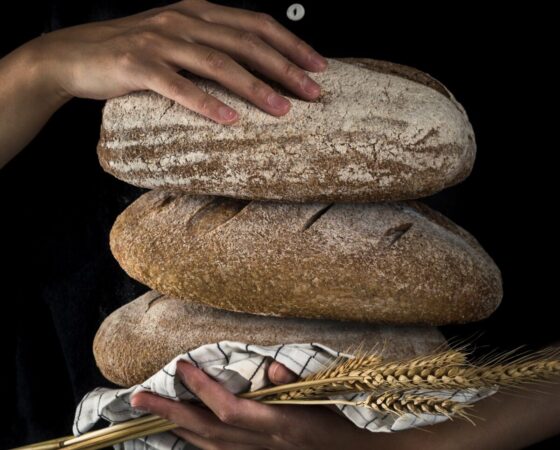TWELFTH SUNDAY AFTER PENTECOST, AUGUST 15, 2021 | A Sermon based on John 6: 51-58 (RCL) | by David Zersen |
I am the living bread that came down from heaven. Whoever eats of this bread will live forever; and the bread that I will give for the life of the world is my flesh.” The Jews then disputed among themselves, saying, “How can this man give us his flesh to eat?” So Jesus said to them, “Very truly, I tell you, unless you eat the flesh of the Son of Man and drink his blood, you have no life in you. Those who eat my flesh and drink my blood have eternal life, and I will raise them up on the last day; for my flesh is true food and my blood is true drink. Those who eat my flesh and drink my blood abide in me, and I in them. Just as the living Father sent me, and I live because of the Father, so whoever eats me will live because of me. This is the bread that came down from heaven, not like that which your ancestors ate, and they died. But the one who eats this bread will live forever.”
LEVELS OF TRUTH
As a painter, I’ve learned to marvel at the many levels of green color that appear in leaves and grasses across the landscape. Initially, one sees just green, a monochrome color that appears everywhere and is not easy to reproduce accurately. Ultimately one realizes that different kinds of leaves and grasses have many values or lightness and darkness in color. The painter seeks to represent what he or she sees and what is then represented on a canvas is his or her level of truth. Another level of truth for the same color values is held by the scientist who explains that various levels of green color result from the amount of visible chlorophyll, an adaptive light-harvesting accessory pigment. Chlorophyll gives plants their green color because it does not absorb the green wavelengths of white light. That particular light wavelength is reflected from the plant, so it appears green. That explanation represents another level of truth. I don’t reflect on that level of truth as I paint the green values in a landscape, but each level is important in its own way.
Levels of truth in the language of John’s Gospel
Today’s Gospel lesson reflects a level of truth that uses metaphor and hyperbole to make its point. This style of truth-telling can be seen as complex to the reader, although many love John’s Gospel because it uses this approach. It’s important to make a brief comparison between John’s Gospel and the first three Gospels, often called the Synoptic Gospels because they summarize in a similar way common stories and teachings. John’s Gospel, written last of all, perhaps between 90 and 110 AD, reflects the perspective that belongs to a later Christian community that has had opportunity to think about the meanings of Jesus’ words and actions. It’s as if the writer of the Gospel has increased the power of his eyeglasses from 1 to 3 in order to see levels of truth in a more profound way.
The fourth Gospel, for example, does not share the miracle stories so commonly found in the Synoptics, but instead explores seven of these incidents as signs pointing to a level of truth beyond the mere incident itself. Today’s lesson, for example, is a part of a discussion in John 6 that explores the relationship between bread and the bread of life, pointing not just to the multiplication of loaves, but to God who gives bread, including his eternal bread. That bread, says John’s Jesus, is Jesus himself, and eating it can give eternal life.
The level of truth in verses 51-58 is difficult to understand in realistic ways and interpreters down through the centuries have regarded this as the most obscure passage in John’s entire Gospel. The Gospel writer suggests that both the crowd and the Jewish leaders were troubled by the level of truth involved in eating Jesus’ flesh and blood. Some interpreters have felt that this passage is the replacement in the fourth Gospel for the Words of Institution, given that this Gospel does not have the text found in the Synoptics and in 1 Cor. 11: 23-26. Others have felt that in some mystical way Jesus’ followers are being encouraged to appropriate Jesus himself and thus enter into a dimension of life that, in Jesus, lasts forever. In any case, the level of truth being explored here is not uncommon in this Gospel. The Samaritan women at the well, for example, was being offered water that will quench thirst forever (4:4-26) and Nicodemus is encouraged to understand that he won’t be part of the kingdom of God unless he is born again (3: 1-21). The challenge for the disciple is to understand that what satisfies hunger and thirst at one level of truth does not fulfill a person at a deeper level of truth. The challenge to you and me is to ask whether we have placed on our nose the theological eyeglasses with the higher power. The opportunity for us is to let this Gospel help us experience a level of truth beyond mere words and descriptive detail.
Levels of truth in our life today
It’s interesting that Martin Luther addressed the complexities in this passage in his usual earthy way. With respect to eating Jesus’ flesh, he wrote: “This is not the sort of flesh from which red sausages are made.” It is “not such as is purchased in a butcher shop or is devoured by wolves and dogs,” “not a veal or beef found in cow barns”. (LW, 23, Chapters 6-8, CPH, 1959). For Luther there is a connection between eating and drinking, something necessary for survival, and following Jesus, something essential in order to live life fully.
There is a level of truth available to us when we put on our theological eyeglasses and seek to perceive what is less than obvious. Let me give you a practical example from the communion rail. In my earlier ministry, our congregation built a new church, but the architect, who previously had built only power plants, had a poor understanding of the function of the chancel furniture. So we hired another firm to design the chancel. A member of the Board of Elders, Henry Weber, asked if we could design the communion rail differently. Since we all sat in pews looking at one another’s backs, he asked, could this be a setting in which we who were being forgiven and who forgave one another could look one another in the face? I shared that story with a Finnish Lutheran pastor who told me that the half of the circular rail around which the communicants knelt, they were taught in Finland, was only half of the circle. The invisible half was populated by the saints in light! I will never forget those two illustrations when I approach the Communion table. One level of truth was created by the architect. The other level, far more profound, is understood by those who believe that God is drawing them into a communion with Jesus whose love and forgiveness are at the center of our faith.
It is one thing to come to grips with words like “unless you eat the flesh of the Son of Man and drink his blood you cannot have life within you”. The Jews rightly said “we know his family” so how can he talk about having us consume him in some supernatural way? They were dealing with only one level of truth. But John’s Jesus is pressing them to experience and grasp something deeper. As John wanted to put it, he was providing a sign that pointed to a deeper meaning. That meaning is not easy to put in words, so figures of speech, often used in otherwise inexplicable poetry, are used. Ultimately there is in doctrinal terms like forgiveness and salvation and communion a need for what artists can draw and musicians can compose. It’s important periodically to ask ourselves when we are troubled by a comment or an action on the part of another, “Have I understood the real meaning or the ultimate level of truth here?”
There is a well-known film that I think helps me make my point. It’s called “Places in the Heart”. It’s a troubling story about racial tension and broken relationships and dead-end attitudes. At the end, however, when you think there’s nothing good that can come from this mixture of evil people and very kind ones, there is a communion service participated in by some whom the movie audience might like to have removed. And even more astonishing, the faces of the dead characters who have been murdered in the story join in as well.
To say it in church language, the church militant and the church triumphant came together at that moment and shared a level of truth that words could not have approached. A medium like film, however, can help us to understand that those who were eating bread and wine were transformed into Jesus himself. Just as Jesus forgave those who betrayed him, so the characters in the film came to forgive one another. Just as Jesus’ love overcame the world in that setting, so you and I are also being called to explore a level of truth more profound than we might have imagined.
Troubled as we may be by a mere literal eating of Jesus’ flesh and blood, we are being called to use meanings, metaphors and signs beyond mere words. The person who says there is no God because he/she can explain origins scientifically has not yet probed the full meaning of a God beyond the gods. The person who says that he/she cannot ever forgive someone for what has been done has not yet explored the meaning of his/her own forgiveness. The person who says that “sin” does not apply to him/her has not yet asked a brother or sister how his/her actions have caused pain. There are levels of truth that we have not pursued in our daily lives because we focus only on specific words or actions and not only ultimate meanings.
Living forever by eating the bread of life may sound like so many words or they may involve introspection and contemplation that we aren’t ready for today. However, this much can be clear, even for you. Jesus, the friend of sinners, loves you with an eternal love that draws you to him. He wants it to shape your life and destiny. He wants you to rejoice in this greater truth, as St. Paul later put it (1 Cor. 13:6). He wants that joy in his love to bind you together from this day forward.
—
Song: “I am the bread of life” by John Michael Talbot
The Rev. David Zersen, D.Min., Ed.D., FRHistS
President Emeritus, Concordia University Texas
djzersen@gmail.com

